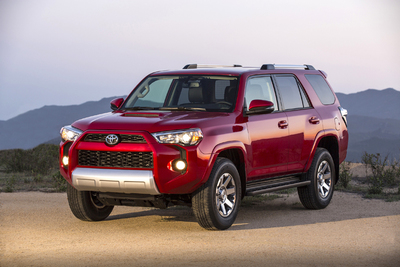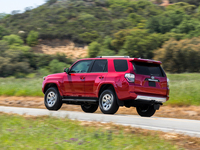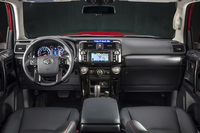2016 Toyota 4Runner Trail Premium 4x4 Review by Carey Russ +VIDEO
 2016 Toyota 4Runner Trail |
Rough and Tumble Capable, But Civilized Too
DRIVING DOWN THE ROAD WITH CAREY RUSS
• SEE ALSO: Toyota Research and Buyers Guide
 |
Set the wayback machine to 1984. Toyota essentially took out the partition between the cab and bed of its compact pickup truck, added a detachable camper shell and removable rear jump seats to create the 4Runner. It was a two-door utility machine with serious offroad capability in a compact package that made trail use easy, and offered better fuel economy than most competitors. It proved popular with outdoors enthusiasts who needed a vehicle that could deal with forest roads and worse to get to camping, climbing, fishing, hunting, or four-wheeling spots, and to whom "luxury" meant a dry place to sleep, not opulent comfort with gourmet room service.
A few years later the "sport-utility vehicle" (SUV) fad began. People for whom "serious offroad adventure" meant maybe a muddy stadium parking lot liked the utility style, but wanted more than basic comforts and conveniences. The 4Runner was revamped to appeal to that more numerous clientele, while still suiting the needs of the get-dirty crowd. The rear shell no longer detached, and soon the two-door variant went away. When the third generation debuted for 1996, in response to market demands it had moved further upscale, gotten a bit larger and more comfortable, and had more safety features.
2001 saw the entrance of Toyota's Highlander crossover to cater to the city and suburban market, freeing the 4Runner to do what it always did best -- get dirty. It even got V8 power in 2003, and lost its connection to the pickup as from then on it has been based on a platform used, in other markets, for the Land Cruiser Prado. That meant a stiffer, fully-boxed frame with independent double A-arm front suspension and a well-located solid axle at the rear for serious off-road and towing use.
The last major update was in 2010. If its exterior style seemingly didn't change much, nearly everything under the skin was different. A new 4.0-liter V6 replaced the V8, and out-powered it by ten horsepower, with improved fuel economy. The 157-hp 2.7-liter four carried on, for a while.
2014 saw a mid-product cycle refresh with revised exterior styling and an upgraded interior. Trim levels at that time were SR5, SR5 Premium, Trail, Trail Premium, and Limited. TRD Pro was added later. If a Trail isn’t offroad enough for you, there’s your 4Runner. All except the Trail and TRD models are 4x2 or 4x4; Trail or TRD means 4x4 only, a part-time, all-terrain capable system with 4-low mode. Power for all is from a 270-hp 4.0-liter V6 with a five-speed automatic.
SR5 and Limited models have optional seven-passenger seating, with a fold-down third row in the rear. My test truck -- most definitely not car, and proud of that -- for the past week was a Trail Premium. No available third row in that -- you don't want to put the young ones back there on a bouncy dirt trail! Especially in Trail trim, the 4Runner makes no apologies for being a truck. You climb up into the cabin, have a commanding view of the world once in, and, although the ride quality is very good for a truck, the solid rear axle makes its presence known. In a world where the interface to the electronically-controlled multi-mode 4WD system is usually some sort of knob, the 4Runner's extra shift lever stands out. This is a traditionalist's four-wheeler, even with all of the upscale conveniences available. Sometimes you don't want a car, and the Toyota 4Runner is just the truck for those times, especially if bad "roads" and/or weather are involved.
APPEARANCE: “Pugnacious” is the word. The 4Runner is not going for any "cute ute" award. Mere crossovers attempt an off-road look with plastic imitation skid plates that are more useful for style than for dealing with rocks and tree stumps. Here, what looks like a steel skid plate is a steel skid plate, with more protecting other important bits underneath. Running boards are useful in civilization, especially for shorter people. If you're really going seriously off road, you know better, and there were no sacrificial running boards on my test truck.
 2016 Toyota 4Runner Trail |
COMFORT: As capable as the Trail Premium can be in the rough, it seems far too civilized inside to be subjected to mud, dirt, and grime. Power heated front seats, power windows including the tailgate, plus moonroof and locks, and plenty of interior storage and all of the current electronic infotainment amenities are found here. Materials and fit and finish are as expected in a premium Toyota, first rate. The shift knob and steering wheel rim are leather; the "SofTex" leatherette upholstery could be mistaken for real leather. Optitron electroluminescent gauges are easy to see in all light, and the controls are logically placed and easy to reach. Visibility is good except close-up at the rear -- the backup camera is an essential there. Front seating position and comfort are very good. Sections of the 40/20/40 split rear seat have adjustable back angle or can be folded as use dictates. There is a real spare tire, outside and underneath the rear where it belongs. My test truck had the sliding rear cargo deck, which is as it says and slides out a bit and has some storage underneath.
SAFETY: 4Runner passengers are protected by Toyota's Star Safety System™, which integrates antilock brakes (on four-wheel vented discs in this case), Brake Assist, Electronic Brake Force Distribution, and Vehicle Stability Control with Traction Control into one comprehensive electronic system. There is a full complement of airbags, front, front seat side, and full-length side curtain, plus driver and front passenger knee airbags. Side impact protection door beams, daytime running lights, and a tire pressure monitoring system offer further protection. A backup camera or rear sonar help minimize problems when backing.
RIDE AND HANDLING: Yes it's unapologetically a truck. And it has plenty of weight -- 4750 pounds worth -- and a high center of gravity thanks to 9.6 inches of clearance in 4x4 form. But that doesn't mean it's a bouncy, rough-riding beast. Anything but — the air-suspension effect of its 265/70R17 tires helps there. It feels moderately soft on pavement, with very good ride comfort. 1985 was a long time ago. If you like the 4Runner, but don't plan on serious off-pavement excursions, go for a 4x2 model. The 4x4 system in SR5, Trail, and TRD models is a dual-range, part-time one meant for real off-road duty, with the suspension, clearance, and technology for that, especially in the Trail and TRD Pro, which have a locking rear differential, Multi-Terrain Select, which changes the permitted amount of wheelspin, for better control in loose mud or deep dirt or on slickrock, and CrawlControl, an electro-mechanical system best thought of as 4-lo cruise control. The optional Kinetic Dynamic Suspension System (KDSS), disconnects the stabilizer bars for greater axle travel in slow, tricky conditions. Articulation! The 4x4 Limited uses a full-time system with a Torsen center differential that should be nearly as capable in rough conditions and far more useful in slightly more civilized situations like winter driving to the ski slopes. And yes, my 4x4 Trail Premium tester stayed in 2WD mode for the entire week. Which was just fine for dealing with deferred-maintenance alleged pavement and the rolled curb at the end of my driveway.
PERFORMANCE: Power comes from a dual overhead cam, 24-valve, aluminum alloy 4.0-liter V6. That’s the only engine choice, and it’s perfectly-suited to its job. With 270 horsepower (at 5600 rpm) and 278 lb-ft of torque (at 4400 rpm) and a wide, flat torque curve thanks to VVT-i variable cam phasing and valve lift on all camshafts, the 4.0-liter V6 ensures plenty of ability for everything from the daily commute to serious trail duty. It's matched to a five-speed automatic with manual-shift mode, and the pair work together very well and efficiently, considering the 4Runner's size and mass. Acceleration is not a problem, and the four-wheel vented antilock disc brakes are up to the task of stopping 4750 lbs of 4Runner. EPA fuel estimates are 17mpg city, 22 highway. With a bias to city and secondary roads, I got an 18 mpg average for the week. Towing capacity is rated at 5,000 pounds, which means small to medium boats, camping, motorcycle, and even car trailers should present no difficulties.
CONCLUSIONS: The last of its kind, the Toyota 4Runner shows just how good a real truck can be. And properly-equipped, it’s ready for anything even remotely resembling a road.
SPECIFICATIONS
2016 Toyota 4Runner Trail Premium 4x4
Base Price $ 39,095
Price As Tested $ 41,345
Engine Type DOHC 34-valve aluminum alloy V6
Engine Size 4.0 liters / 241 cu. in.
Horsepower 270 @ 5600 rpm
Torque (lb-ft) 278 @ 4400 rpm
Transmission 5-speed automatic
Wheelbase / Length 109.8 in. / 190.2 in.
Curb Weight 4,750 lbs.
Pounds Per Horsepower 17.6 Fuel Capacity 23 gal. Fuel Requirement 87 octane unleaded regular gasoline Tires P265/70 R17 113S Dunlop AT20 Grand Trek m+s Brakes, front/rear vented disc all around, ABS, EBD, BA, VSC standard Suspension, front/rear independent double-wishbone / solid axle with coil springs and 4-link location Ground Clearance 9.6 inches
Drivetrain front engine, part-time dual-range 4-wheel drive
PERFORMANCE
EPA Fuel Economy - miles per gallon city / highway / observed 17 / 21 / 18
0 to 60 mph est 8.5 sec
Towing Capacity 5000 pounds
OPTIONS AND CHARGES
Sliding rear cargo deck with underfloor storage compartment $ 350
Kinetic Dynamic Suspension System (KDSS) $1,750
Keep It Wild Savings -$ 750
Destination Charge $ 900


